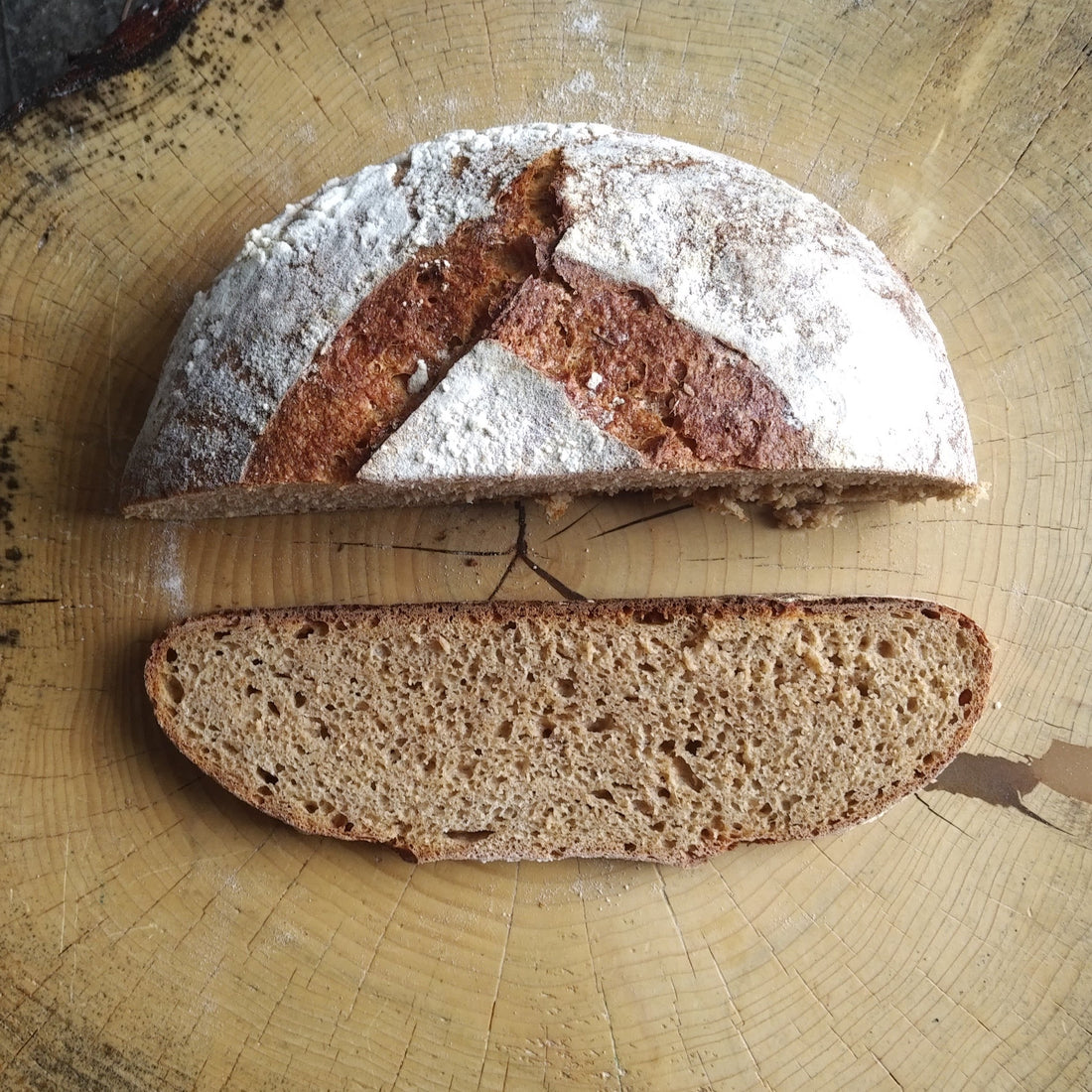Einkorn sourdough bread has a beautiful golden colour and rich, earthy flavour. This grain is known for its digestibility - if you have gluten sensitivities we recommend you start here and see if your symptoms clear up. Not only digestible and delicious it is also high in protein, low in starch and high in vitamins and minerals.
Heritage wheats are generally more extensible and less elastic than their modern counterparts and don't benefit from prolonged autolyse or fermentation times which can allow enzyme activity to break apart proteins, creating even further extensibility. In addition, freshly stoneground flour is high in enzymes. We recommend watching the dough carefully to ensure that bulk fermentation doesn't go too long, and erring on the side of slightly under-proofing the dough to improve structure and oven spring.
This is a 75% hydration dough. It will feel like a sticky dough, but the hydration will create a moist, open crumb. You can reduce to 65% hydration to make it easier to work with if you'd like. Once you have read through the recipe and understand the times required in each step you can adjust to suit your schedule.
Makes 2 loaves
Leaven:
1 Tbsp mature starter
200g warm water (24C)
200g Whole Grain Einkorn flour
Bread:
200g leaven
750g warm water (24C)
1000g Whole Grain Einkorn flour
18g fine sea salt
Day 1 (morning):
Make the Leaven: Discard all but 1 Tbsp of starter. Add warm water, stir to dissolve starter in water. Add 200g Einkorn flour. Stir to combine, cover and let sit at room temperature 6 - 8 hours. In should look aerated with tiny bubbles throughout, will have increased in size by about 60 percent, and should be able to float on water. It should also smell sweet, rather than sour.
Mix the dough: Pour the warm water into a large mixing bowl. Add 200g leaven and stir to combine. Add the flour and salt and mix thoroughly. Cover the bowl with a clean kitchen towel and let rest for 30 minutes.
Bulk fermentation: After the 30 minute rest, stretch and fold the dough: Using a wet hand, grab the underside of the dough, stretch it up, and fold it back over the rest of the dough. Repeat this 3 or 4 times so that all of the dough gets worked. This is considered 1 turn. Cover, allow to rest 35 minutes and then complete another turn. Repeat until you have done 3 turns. After the 3rd turn, cover the dough and allow it to rise until it has increased in size by 30 percent, about 1 hour. If your kitchen and dough is cool this final rise time may increase.
Pre-shape and bench rest: Using a wet hand, gently turn the dough out onto your bench and divide into 2 equal portions, about 1000g each. Fold the dough in half, and using your bench scraper and damp hand shape the dough into a tight ball, seam side down. This begins to develop surface tension in the dough. Do the same to your second portion of dough. Cover the dough with a kitchen towel and let rest for 15 minutes.
Shape and final proof: Line 2 9-inch proofing baskets or bowls with clean kitchen towels and sprinkle with a mix of Einkorn flour and whole rice flour. The rice flour acts like ball bearings and will prevent the dough from sticking to the towel. Lightly flour the surface of one dough ball, and then flip it over onto a lightly floured surface. Gently pat it down, being careful not to deflate it too much. Fold the bottom third up toward the centre, followed by each of the sides and then the top. Finally, fold the bottom third up again, this time using this movement to flip the dough over so that the seam is on the bottom. Repeat with the second pre-shaped loaf. Allow the dough to rest 15 minutes to help seal the seam. Place each loaf, seam side up, in one of the proofing baskets or bowls. Cover with a kitchen towel and transfer to the fridge for overnight cold fermentation.
Day 2 (morning):
Put a deep dutch oven/combo cooker in the oven and pre-heat to 500F for half an hour. Just before baking, remove one loaf from the fridge. Remove the base of the dutch oven from the oven and gently transfer your loaf, seam size down, into the shallow base of the dutch oven. Score (cut a slit along the top to direct the expansion of the bread), cover with the deep lid of the dutch oven and put into the oven. Bake for 20 minutes, then reduce the temperature to 450, remove the lid and bake for another 20 minutes at until deep golden brown. Carefully remove the loaf from the dutch oven and allow to cool on a wire rack. Allow the dutch oven to return to 500F before baking the second loaf.

